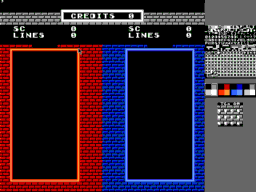Hello. I'm releasing some NES source code I've written.
It basically contains most stuff necessary to make a full 2D scroller; a graphics engine, music+sfx engine, object engine (including collision detection, physics), animation, Huffman text decoding, palette fading, and a virtual machine for scripting game logic.
I've also integrated everything into a small demo which shows some of the capabilities. The total amount is 11,000+ lines of code split across 70 linkable units, which should be conveniently browsable by name.
The source code is currently at
http://www.stud.ntnu.no/~kenth/ntxdev.zip
You'll need the latest version of my assembler+linker, and (GNU) Make, to build it:
http://www.stud.ntnu.no/~kenth/xorcyst
I've compiled a ROM for those interested in that:
http://www.stud.ntnu.no/~kenth/ntxdev.nes.zip
I have made a number of tools to create levels, encode text, assemble game logic scripts etc., but it takes some effort to package it and document it properly, so I'll hold off releasing it until someone asks.
Most of the source code and internal data formats are well documented (I hope). I should really write some detailed articles though, but it takes a lot of time...
The code is still under heavy development, as there's much to be done before I'll be back at the functional level I was with the old X816 code base, but there's enough stuff in there already for starters.
Have fun!
(And thanks to Tootai for the monochrome bird used as test enemy (the image before conversion was much better, sorry about that...))
It basically contains most stuff necessary to make a full 2D scroller; a graphics engine, music+sfx engine, object engine (including collision detection, physics), animation, Huffman text decoding, palette fading, and a virtual machine for scripting game logic.
I've also integrated everything into a small demo which shows some of the capabilities. The total amount is 11,000+ lines of code split across 70 linkable units, which should be conveniently browsable by name.
The source code is currently at
http://www.stud.ntnu.no/~kenth/ntxdev.zip
You'll need the latest version of my assembler+linker, and (GNU) Make, to build it:
http://www.stud.ntnu.no/~kenth/xorcyst
I've compiled a ROM for those interested in that:
http://www.stud.ntnu.no/~kenth/ntxdev.nes.zip
I have made a number of tools to create levels, encode text, assemble game logic scripts etc., but it takes some effort to package it and document it properly, so I'll hold off releasing it until someone asks.
Most of the source code and internal data formats are well documented (I hope). I should really write some detailed articles though, but it takes a lot of time...
The code is still under heavy development, as there's much to be done before I'll be back at the functional level I was with the old X816 code base, but there's enough stuff in there already for starters.
Have fun!
(And thanks to Tootai for the monochrome bird used as test enemy (the image before conversion was much better, sorry about that...))
